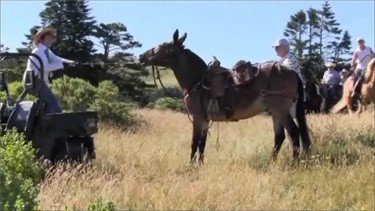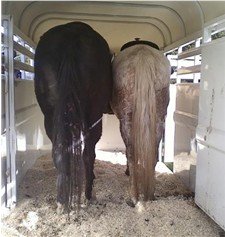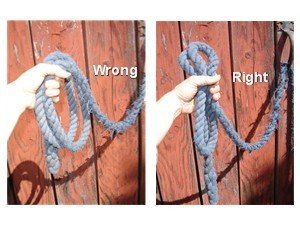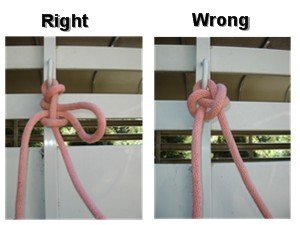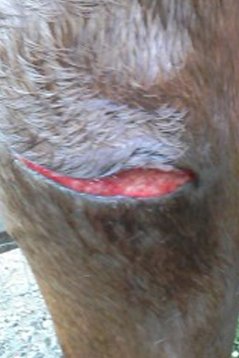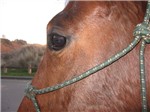Equestrian Safety
For You
and the Horse You Rode In On
Learn how to be safe around horses with tried-and-true equestrian safety tips. Avoid common mistakes and learn valuable lessons from other people’s poor judgment.
Whether you are new to horses or not, safety is king. The fact is… horses are big animals. That means you have to be on your toes when it comes to your health and well being. And they are animals. Meaning you have to be the brains of the bunch and keep them free from harm as well.

3 Good Reasons to Practice Equestrian Safety
- Doctor and vet bills are expensive!
- Pain hurts
- Avoid looking like an idiot
In a perfect world every horse would be well mannered and trained to perfection. But this is not fantasy land. In the real world we have young horses, green horses, poorly trained horses, spooky horses, cantankerous horses, fearful horses….and fantastic horses that sometimes have bad days.
When it comes to equine safety you’ll find that most of it is just plain ol’ common sense. But what you don’t know can hurt you, so I’ve compiled this list of safety tips that every horseman can benefit from.
Around the Animals Ropes, Knots and Hands Paddock and Pasture Trailer Safety
Equestrian Safety
Up Close and Personal
Horses tend to move around, sometimes unexpectedly. You must anticipate any sudden movements and keep your body in a safe place. They are fast, strong and outweigh you by several hundred pounds. So…
- Be aware of your body’s relationship to the horse’s body at all times. The safest place to stand next to a horse is at the shoulder. If the horse moves its rear end, you’ll be out of the way. If he suddenly swings his head, you’ll be out of the way. If he steps sideways toward you, you can push him away or move sideways with him.
|
I was once dumb enough to have my face over my mare's head while she was lying down. She decided to get up. The first thing a horse does to get off the ground is throw their head in the air. It’s like getting slammed in the face by a 200 lb bag of potatoes! It hurt so bad I nearly passed out. She didn’t even notice. You can bet I won’t do that again!
- When walking behind a horse, walk far away or extremely close. If you are passing by horses, stay out of kicking range… 5-6 feet. If you are grooming a horse and you want to pass to the other side… stay a close 5-6 inches from the tail. If a horse does decide to kick, 1-3 feet away is the worst place for you to stand. That gives him plenty of room to really get in a good hard swing at you with those hoofs. Don’t give him the extra leverage.
- When you are leading a horse, stand at the shoulder. If you are in front of her, she can knock you down. At the shoulder, you maintain control even if the horse becomes out of control. If he suddenly bolts forward, you can pull his head toward you, forcing him into a circle. Let him run circles around you, while you remain safely in the center.
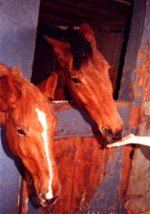 Keep your hands flat
Keep your hands flat- When you are holding your pony for the farrier, stand on the same side of the animal as the farrier is working. This is for your farrier’s safety as he is working in a vulnerable position. If the horse acts out or lunges, you can pull the animals head toward you, therefore moving the body away from him. Believe me, he'll appreciate your good equestrian safety measures.
- Unless you’re really familiar with the horse, don’t just stick your hand in their groin, teats or flank area. A lot of horses take offense to this and will respond with a kick or a bite.
- When offering a horse treats, keep your hand flat like a dinner plate. Horses have a very strong bite with those teeth. Keep your fingers out of their mouth.
Did you know the end of a horse’s nose is in his blind spot? He can’t even see your fingers down there!
- When you are approaching horses, talk out loud to them as you move closer. Just like you do when you talk to dogs and small children. Especially if the animal is distracted eating hay or something. Horses don’t appreciate being startled and can react swiftly to your disadvantage. Announce your presence and let them know you are there. They’ll appreciate it.
- This one’s a no-brainer when it comes to equestrian safety.…don’t let little kids run up to a horse! They tend to startle horses and do dangerous things like grab the horse’s legs and crawl under their bellies. Keep an eye on the little ones…

Equestrian Safety
Ropes, Knots and
Hands
A rope is an essential tool for the horseman. But like anything else with horses, they can find a way to get hurt on it or hurt you with it.
- When you have a rope in your hand and there is a horse attached to the other end of it…Don't hold the rope coiled around your hand. Instead, fold it accordion style and wrap your hand around it. Holding your hand in a coiled rope it like placing your hand in a trap and hoping it won’t go off.
- If you ever find yourself holding onto a rope with a freaked out panicked animal on the other end…Do not try to win a tug of war contest. You WILL Loose. Loosen your grip on the rope and catch the horse up later.
One of my family members tried to hold a rope with a wild mustang on the other end. They didn’t just get a rope burn. No. The rope chewed through the leather cloves, through the flesh and removed bone from the finger. That finger was almost lost and now has one joint completely missing.
- equestrian safety is always using a slip knot to tie your horse. A slip knot will quick release with the pull of a rope, yet remains securely fastened from the horse’s perspective.
- Don’t use the reins on your bridle to tie your animal. For one, it can damage his mouth if he pulls too hard. And two, they can easily be broken. Use a halter and lead rope.
- Don’t tie your equine with so much slack in the rope that they can get their foot caught up in it. That’s just a nasty rope burn waiting to happen.
- Don’t tie your horse to something they can pull out. I once saw a girl tie her Arabian gelding to the gas pipe line leading into her house. Talk about a bad idea!

Equestrian Safety
Baby-Proofing the
Paddock
As the saying goes, “Never underestimate a toddler”. The same holds true for equines. Horses truly are like small children. If there is a way for a horse to get hurt on something…they will find it. They are big, strong and curious, all of which has the potential for trouble in the making. Ask yourself, “Can my horse get hurt on this?” If the answer is yes, fix it.
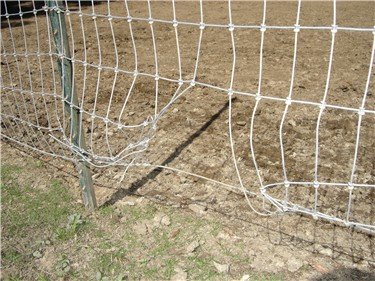 Horses put a hole in this fence!
Horses put a hole in this fence!- Make a habit of walking the fences. Horses are hard on fences. They chew wood, push on wire, lean on posts and some times flat out run into them at high velocity. Wire cuts are all too common an injury. Check your fences and keep them in repair.
- While you are walking your pasture check for leg breakers like holes and heavily exposed tree roots.
- Take the extra equestrian safety measure to check for poisonous plants, loco weed and such; that may be trying to take hold.
- Use plastic caps to cover T-post fence stakes. It’s cheap insurance....
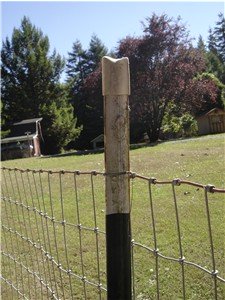 A properly capped T-post
A properly capped T-postA good friend of mine has transported two horses, on two separate occasions to the vet for two of her neighbors. Both horses had been impaled with a T-post. One horse survived, the other did not.
- Inspect stalls and shelters for exposed nails, failing latches or loose gates that a horse can get a hip hung up on.
- Make sure your electric fences are working. I hate it when my neighbor’s mules get out on the road. Can you imagine if one were to get hit by a car? Law suit!
- Make sure automatic water pumps are working.
- Check that electric water heaters are not shorting out and electrocuting the horses every time they try to take a drink.

Equestrian Safety
In the Trailer
Believe it or not, getting your horse in and out of the trailer is risky business. It’s fraught with potential disaster. Think about it. You are asking your horse to get in a small enclosed area with low visibility (claustrophobic for a large prey animal).
And then you are going to ask them to blindly (can’t see behind them) walk backwards down a ramp or a step down after having been on a maybe-not-so-nice ride on the road. Road travel is stressful. Horses can get tired, road weary and just as bothered by traffic and road conditions as we do.
Run the end of an extra long lead rope through the trailer tie. Then you can pull/guide the horse into the trailer while you are standing safely outside. This is also a safe way to unload them as well.
- When you are loading a horse into a trailer, don’t get yourself boxed in. Make use of the escape door. If you haven’t an escape door available, use a long line to guide your horse in.
- Don't stand directly behind a horse getting in or out of a trailer. A horse that has just had an uncomfortable trailer ride will often try to rush out. Often at inopportune times. Get in the habit of making your horse stand for a moment after you have released the butt chain. Teach her to wait for your command to back out.
- Make a habit to inspect your trailer floor every once in a while for signs of rust and rot. A horse’s hoof punching through the floor out on the road is unthinkable.
- Take a walk around your rig and check your tires, lights, safety chains and hitch hookup before you pull out.
- Make your trailer safer. Add quick release safety snaps to the tie downs and butt chains. Add a plastic bumper to the edge of your step-down trailer if is doesn’t already have one. Add fender trim to the underside of the sharp metal fenders.
Most trailers have tie rings just above the fenders. A friend’s horse cut his leg severely on her trailer fender. Another friend of mine had a horse back out of a step down trailer and slip on the gravel outside. His back legs slid under the trailer. When he tried to right himself, he stripped the flesh off of both back legs. A plastic bumper and/or shipping boots would have helped this situation.
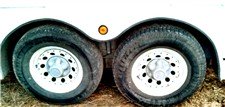 Fender edges can be sharp Fender edges can be sharpMany horses are tied next to trailer fenders with sharp edges. Fender trim for horse trailers will protect them from getting cut. |
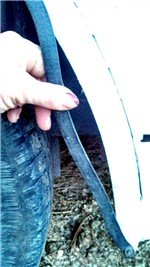 Fender trim covers sharp edges Fender trim covers sharp edges |
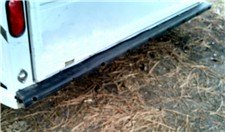 Rubber bumpers protect legs Rubber bumpers protect legsRubber bumpers like this one protect horse's legs. |
When it comes to equestrian safety, I've seen people do some stupid things. I've done some stupid things. Hopefully you won't make the same mistakes. Half the battle of accident prevention is anticipating potential hazards and avoiding setting yourself up for a disaster in the first place. Over time, most of it becomes second nature.
Even so, it’s easy to get comfortable and lazy, especially when you've been around horses a lot. There are a lot of wonderful, calm, sensible horses out there; but horses are horses and even good ones can have bad days. Learn to expect the unexpected. Think ahead and be aware. It's all about human and equine safety.
P.S.
When you’re riding down the trail….don’t ride where you can’t see what your horse is stepping into. And for Heaven's sake don't try to ride across a cattle guard…..yup....it's been tried....really, really bad idea...
Speaking of safety, this is one clever idea. See how one woman turned a tragedy into a solution.
More Equine Safety Articles:
Home > First Horse & Beyond > Equestrian Safety
